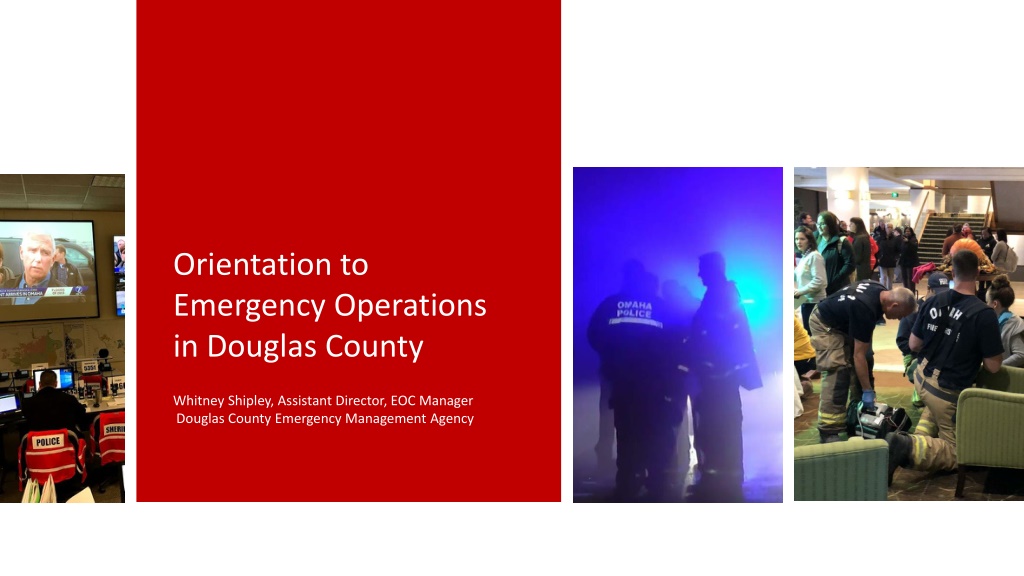Orientation to Emergency Operations in Douglas County
Whitney Shipley, Assistant Director and EOC Manager at Douglas County Emergency Management Agency, provides an overview of key understandings and planning assumptions, threat identification, vulnerability assessment, and risk management in Douglas County. The orientation covers disaster management cycle, core capabilities, community lifelines, recovery framework, EMA and EOC operations, and building resilience through public-private partnerships.
Download Presentation

Please find below an Image/Link to download the presentation.
The content on the website is provided AS IS for your information and personal use only. It may not be sold, licensed, or shared on other websites without obtaining consent from the author. Download presentation by click this link. If you encounter any issues during the download, it is possible that the publisher has removed the file from their server.
E N D
Presentation Transcript
Orientation to Emergency Operations in Douglas County Whitney Shipley, Assistant Director, EOC Manager Douglas County Emergency Management Agency
Key Understandings and Planning Assumptions: 1. Information provided here today describes general practices for local community emergencies/natural disasters managed through traditional public safety and emergency management channels. Some exceptions apply. 2. Many variables influence incident response and management strategy and resource management options and operations. 3. Past incidents are not precedent setting.
Overview Threat, Vulnerability, and Risk Damage Assessment Disaster Management Cycle Core Capabilities Community Lifelines Recovery Framework Douglas County EMA and EOC Operations Building Resilience through Public-Private Partnerships
Threat Vulnerability Risk What types of occurrences might occur in Douglas County that hold the potential to negatively impact the health and safety of the community? Likelihood x Impact For each of these types of incidents, what weaknesses exist that could be exploited by an aggressor or, in the case of a non-terrorist incident, make an asset or the community susceptible to damage? How likely is the event to occur here and what is the potential magnitude and type of impact, if it does? Nebraska Emergency Management Act defines: Civil Defense Disaster Emergency (aka CEND Incidents )
Threats Identified for Douglas County Readyomaha.org or Readydouglascounty.org
Elements of Vulnerability Any weakness that can be exploited by an aggressor or, in a non-terrorist threat environment, make a community susceptible to hazard damage. Example: High water table Limited access Low water pressure Fluctuations in water level Population density
Elements of Risk What proportion of the population? How large of a geographic area? National Risk Index: https://hazards.fema.gov/nri/map Potential for disruption of utilities > 72 hrs. Duration of incident? Potential for injury or loss of life? Potential for severe damage? Potential to impact commerce? Potential to disrupt communications? Disproportionate cultural impact? Public perception/fear? Potential to disrupt transportation?
Patient Level 1. Personal Protection 2. Scene Size-Up 3. Primary assessment, immediate life-saving interventions 4. History taking 5. Secondary assessment/interventions 6. Continual reassessment Transfer to definitive care 7. Similar process and priorities are applicable at the community level
Did the incident disrupt service to survivors? What is the extent of the disruption and impact on the response and survivors? Has a solution to the disruption been identified? Has that solution been converted into a plan of action? Has that plan of action been resourced? Are there limiting factors that are providing stabilization? To what extent are they degrading services? Have services for survivors been stabilized? If not, how long to reach stabilization? Are their contingency solutions that are enabling stabilization? How long will these solutions be used to sustain stabilization? Have circumstances changed wince the lifeline/component was last assessed?
Recovery Recovery The nine most terrifying words in the English language are: I m from the Government, and I m here to help. Local Primacy Ronald Reagan, 1986
Douglas County Command and Coordination Emergency Management Senior Advisory Team (MAC Group) Joint Information Center (JIC) Incident / Unified Command (IC/UC) Emergency Operations Center (EOC) On-Scene or in Command Post/Center Off-Scene, often convening virtually
Levels of Emergency Operations Management Activation LEVEL FEMA CORE CAPABILITIES Level 1 Monitoring & Exchange of Info Situation Assessment Operational Communications How and by whom are these capabilities met? Level 2 Assessment of Risk with Proactive Measures Situation Assessment Operational Communication Operational Coordination Public Info and Warning Planning Public Info and Warning Operational Coordination Situation Assessment Infrastructure Systems Critical Transportation Fatality Management Mass Care Mass Search and Rescue Logistics and Supply Chain Management Environmental Response / Health and Safety Mass Search and Rescue On-Scene Security, Protection, and Law Enforcement Operational Communications Public Health, Healthcare and EMS Fire Management and Suppression Level 3 Response with Local Resources and Level 4 Response with Outside Assistance Planning Public Info and Warning Operational Coordination Infrastructure Systems Economic Recovery Health and Social Services Housing Natural and Cultural Resources Recovery Short Term and Long Term
Community Lifelines SENIOR OFFICIALS FEMA/ FEDERAL AGENCIES NEMA/ STATE AGENCIES LOCAL EMERGENCY MANAGEMENT INCIDENT COMMAND
Perception Disaster Proclamation * Reality
Building Resiliency through Whole Community Engagement
Douglas County Emergency Operations Center
How might we be of assistance in meeting your mission? Thank you! Whitney Shipley Whitney.shipley@douglascounty-ne.gov























